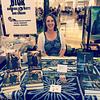Take a photo of a barcode or cover

kblincoln 's review for:
Love at Goon Park: Harry Harlow and the Science of Affection
by Deborah Blum
As I read the last chapter of this book, snuggled up against my 12 year old daughter, I started telling her how lucky she was to be the younger of my two daughters. I wrestled with the prevailing United States wisdom of the day about when babies should sleep apart as well as when it was weird to not be potty trained.
Luckily, I had the advantage of living when my girls were young in Tokyo, where attachment parenting and sleeping together in family units was the norm, and so when girl1 cried her eyes out for hours on the night we tried to get her to sleep by herself, I decided that an entire country of people who are not sleep-deprived and can go the bathroom just fine, thank you, couldn't be wrong.
Harry Harlow, the "hero" of this look at the way psychology in the 50's thru 70's treated infant development in terms of love vs isolation, didn't have the advantage of seeing Japanese babies literally bundled up and worn in slings by their mothers for most daily activities. Despite the common sense of his times-- that mothers caused Autism, that babies attached to anyone or anything that fed them, that isolation was better hygienically for baby health--he devised an entire program of studies using macaque monkeys that brought us to the common sense attitudes we have today about the importance of touch for babies and the harmful effects of social isolation.
But while 2/3 of the book seems to portray Harry Harlow as a vital, story-telling, passionate researcher who created more-humane-than-most conditions for his primates in his Wisconsin lab, the last third casts a darker shadow.
Harry Harlow's experiments are fascinating (baby monkeys reared with a cloth doll or a wire doll as their mother, baby monkeys isolated from all contact for months, normal monkeys who became depressed and exhibited psychopathic behavior after being thrown into a "pit of despair" funnel box, etc). But the last third of the book challenges the reader on the ethical and moral questions underpinning research that causes such distress.
Whether you wince at the experiment descriptions, or gloss over the suffering of the animals to be reassured by the results supporting the ideas that baby humans need stable, comforting, touching love early on and respond with bravery when faced with freedom later, or are encouraged by experiments with isolated monkeys that received "therapy" and became somewhat normal, the very basic unit of humanity-- our love, our relationships with others-- is a fascinating study.
This book, while possibly seeing Harry Harlow with a tint of rose-colored glasses, and focusing primarily on his healthy years (and not so much his dark, alcoholic years between wives and then death from Parkinson's) and sometimes taking a bit of a poetic license in surmising how the researchers regarded the monkeys, still is quite readable and important part of understanding North American cultural history of the family.
Luckily, I had the advantage of living when my girls were young in Tokyo, where attachment parenting and sleeping together in family units was the norm, and so when girl1 cried her eyes out for hours on the night we tried to get her to sleep by herself, I decided that an entire country of people who are not sleep-deprived and can go the bathroom just fine, thank you, couldn't be wrong.
Harry Harlow, the "hero" of this look at the way psychology in the 50's thru 70's treated infant development in terms of love vs isolation, didn't have the advantage of seeing Japanese babies literally bundled up and worn in slings by their mothers for most daily activities. Despite the common sense of his times-- that mothers caused Autism, that babies attached to anyone or anything that fed them, that isolation was better hygienically for baby health--he devised an entire program of studies using macaque monkeys that brought us to the common sense attitudes we have today about the importance of touch for babies and the harmful effects of social isolation.
But while 2/3 of the book seems to portray Harry Harlow as a vital, story-telling, passionate researcher who created more-humane-than-most conditions for his primates in his Wisconsin lab, the last third casts a darker shadow.
Harry Harlow's experiments are fascinating (baby monkeys reared with a cloth doll or a wire doll as their mother, baby monkeys isolated from all contact for months, normal monkeys who became depressed and exhibited psychopathic behavior after being thrown into a "pit of despair" funnel box, etc). But the last third of the book challenges the reader on the ethical and moral questions underpinning research that causes such distress.
Whether you wince at the experiment descriptions, or gloss over the suffering of the animals to be reassured by the results supporting the ideas that baby humans need stable, comforting, touching love early on and respond with bravery when faced with freedom later, or are encouraged by experiments with isolated monkeys that received "therapy" and became somewhat normal, the very basic unit of humanity-- our love, our relationships with others-- is a fascinating study.
This book, while possibly seeing Harry Harlow with a tint of rose-colored glasses, and focusing primarily on his healthy years (and not so much his dark, alcoholic years between wives and then death from Parkinson's) and sometimes taking a bit of a poetic license in surmising how the researchers regarded the monkeys, still is quite readable and important part of understanding North American cultural history of the family.